
10 Krey Boulevard Rensselaer, NY 12144
August 26, 2014
By Electronic Delivery
Honorable Kimberly D. Bose, Secretary Federal Energy Regulatory Commission 888 First Street, NE
Washington, DC 20426
Re: New York Independent System Operator, Inc., Informational Filing, Docket
No. ER12-1653-00_,
Dear Ms. Bose:
The New York Independent System Operator, Inc. (“NYISO”) hereby submits the
Informational Filing required by Ordering Paragraph D of the Commission’s November 6, 2012 Order1 and Ordering Paragraph B of the Commission’s May 31, 2013 Order.2 In both Orders the Commission requested this Informational Filing be provided fourteen months3 following the effective date of the NYISO’s Order 755 tariff amendments and software changes, implemented in satisfaction of the Commission’s Order No. 755 directives. The NYISO’s Order 755 tariff amendments and software became effective with the June 26, 2013 market day.
I.Background
The NYISO’s Regulation Service4 market schedules suppliers using their capacity offer for Regulation Service and a single, composite price bid made up of the sum of i) the price
offered for Regulation Capacity and ii) the product of the price offered for Regulation Movement and the uniform Regulation Movement Multiplier (“RMM”). The uniform RMM is a multiplier applied to a unit’s Regulation Movement bid to allow the software to treat that price offer as comparable to the price offer for Regulation Capacity and thus to select a marginal resource by evaluating the price offers from all suppliers comparably.
1 New York Independent System Operator, Inc 141 FERC ¶ 61,105 (2012) (“November Order”)
2 New York Independent System Operator, Inc. 143 FERC ¶ 61,194 (2013) (“May Order”)
3 New York Independent System Operator, Inc. 143 FERC ¶ 61,194 (2013)
4 Capitalized terms used but not defined in this filing shall have the meanings given to them in the Services
Tariff.
Honorable Kimberly D. Bose August 26, 2014
Page 2
Day-Ahead and real-time prices for Regulation Capacity and Regulation Movement are set as the Regulation Capacity bid and Regulation Movement bid, respectively, of the marginal resource needed to fulfill the NYISO’s Regulation Service capacity requirement. Included in
these prices are any cross-product opportunity costs that result from the scheduling of Regulation Service on the marginal facility.
Units are scheduled to provide Regulation Capacity and are then dispatched in real-time to provide Regulation Movement. Scheduled resources are paid for the MWh of Regulation Movement provided in response to the NYISO’s Automatic Generation Control (“AGC”) signal at the market price for Regulation Movement. A performance penalty is charged to resources who do not respond adequately to the NYISO’s AGC signal.
II. The Commission’s Questions and a Summary of the NYISO Response
The Commission directed NYISO to file an informational report analyzing:
A) Its experience, including the degree to which the uniform RMM accurately reflects
the dispatched movement of Regulation Service providers and allows the market to
provide appropriate incentives and cost recovery, particularly as regards to the
interaction between the use of a uniform RMM and setting the Regulation Movement
Market Price.5 Do Regulation Movement prices appropriately compensate the
provision of that service?6
B) Whether the uniform RMM accurately reflects the dispatched movement of
Regulation Service providers.7
C) Whether discrepancies between the RMM and the actual movement that regulation
resources are asked to provide impact the efficiency of the ultimate market prices
paid for Regulation Movement.8
D) Whether it would be more appropriate to use resource specific RMMs, including
some method to recognize that faster-ramping resources scheduled to provide
Regulation Capacity likely will provide more Regulation Movement than slower-
ramping resources.9 Given NYISO’s uniform RMM assumption and proposed method for determining Regulation Movement prices, is the Regulation Movement Market Price compensatory?10
5 November Order P 56.
6 Id. P 62; See also text at ft.nt 10
7 Id. P 60
8 Id. P 62
9 November Order P 62
10 Id. P 63.
Honorable Kimberly D. Bose August 26, 2014
Page 3
The Commission also requested that the NYISO submit a compliance filing containing
either a fully-supported demonstration that NYISO’s interim market power mitigation proposal
meets the requirements of Order No. 755 and the November 6, 2012 Order as a permanent
market power mitigation method or tariff revisions proposing permanent market power
mitigation measures that meet the requirements of Order No. 755 and the November 6, 2012
Order.11
The NYISO’s experience indicates that the uniform RMM allows the market to provide
appropriate incentives and supplier cost recovery particularly with regard to Regulation
Movement and that its Regulation Movement prices appropriately compensate the provision of
Regulation Movement service. However, data on the ratio of instructed Regulation Movement
and average procured Regulation Capacity shows that the set point of the uniform RMM may
need to be adjusted to more accurately reflect the current dispatched Movement of Regulation
Service providers.
Nonetheless, the NYISO’s investigation has revealed that any discrepancies between the RMM and the movement that regulation resources are scheduled to provide did not impact the overall efficiency of the market prices paid for Regulation Movement.
The NYISO’s experience also indicates that it would not be more appropriate to use
resource specific RMMs. Appropriate compensation for Regulation Movement results from a uniform RMM and it is unnecessary to use a resource-specific RMM in order to provide
appropriate compensation.12
Finally, the market power mitigation proposal offered by the NYISO in its January 22, 2013 compliance filing meets the requirements of Order No. 755 and the November 6, 2012 Order as a permanent market power mitigation method.
III.Analysis and Conclusions
A. 1. The Uniform RMM allows the market to provide appropriate
incentives.
The uniform RMM is a multiplier applied to Regulation Movement Bids to treat them as
comparable to Regulation Capacity Bids and allow the scheduling and pricing solution to use a
single price bid when scheduling resources to fulfill the NYISO’s Regulation Service
requirement. As explained in the NYISO’s August 17, 2012 filing in this docket, the RMM was
developed by creating a ratio of Regulation Movement MW to Regulation Capacity MW using
data from the 29 month period from January 2010 through May 2012.13 Over the first 9 months
11 New York Independent System Operator, Inc., 143 FERC 61,194 (“May Order”) P 35.
12 A resource-specific RMM would recognize that faster-ramping resources scheduled to provide
Regulation Capacity are likely to provide more Regulation Movement than slower-ramping resources.
13 New York Independent System Operator, Inc. Docket ER12-1653-000, Further Compliance Tariff Revisions, August 17, 2012, at page 3. See also, Attachment I, Affidavit by Rana Mukerji.
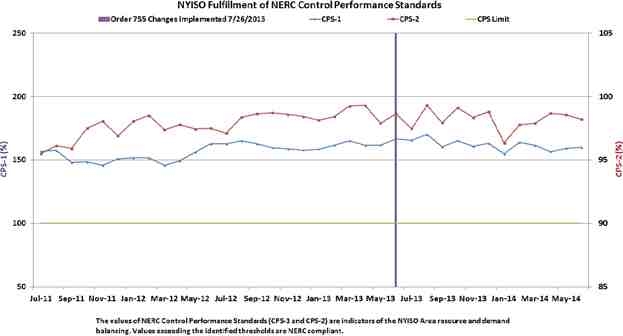
Honorable Kimberly D. Bose August 26, 2014
Page 4
of the new market design, the NYISO’s analysis of the amount of Regulation Movement
instructed per MW of Regulation Capacity procured revealed that a reasonably accurate predictor of the amount of Regulation Movement the NYISO will procure is the historical average ratio between the MW of Regulation Movement provided to the amount of average amount of
Regulation Capacity scheduled.
The NYISO performed a time series analysis including observations of instructed
Regulation Movement from June 30, 2013 to March 31, 2014. No overall noteworthy trends or
regular seasonal fluctuations were found in the amount of Regulation Movement scheduled over
this time period. This reveals that an average ratio of Regulation Movement to Regulation
Capacity can adequately predict the amount of Regulation Movement per MW of Regulation
Capacity that will be scheduled. In other words, history is a reasonable predictor of the future
and the RMM reasonably represents how much Regulation Movement any resource will be
instructed to provide.
In addition, the use of a uniform RMM has not negatively impacted reliability metrics.
The NYISO has maintained CPS1 and CPS2 reliability compliance while using a uniform RMM
to establish market prices for Regulation Movement and Regulation Capacity (see Figure 1).
FIGURE 1
Honorable Kimberly D. Bose August 26, 2014
Page 5
A. 2. The use of a uniform RMM with the current Regulation Service
market-based pricing methodology allows adequate cost recovery for Regulation Service.
The current pricing methodology for Regulation Movement, as mentioned above, will
compensate a resource at a market price for Regulation Movement which, on a per MWh basis,
may be less than its MWh bid for Regulation Movement. However, the NYISO guarantees with
a supplemental payment the difference between the day’s compensation for energy and Ancillary
Services provided and the day’s bid-in cost for those services.14 By analyzing its time-series of
data from from 6/26/2013 to 6/30/2014, the NYISO determined that the bid-in costs for
providing Regulation Service were covered by compensation for that service most days for
almost all units.
As presented in Figure 2, on the majority of days in which units bid, resources were able to cover their real-time bid costs for Regulation Service with the real-time market prices for Regulation Service. Figure 2 illustrates positive and negative daily net revenue15 from each unit providing Regulation Service. The dark blue bars represent instances where a unit’s sum of net revenue from providing RT Regulation Capacity and RT Regulation Movement was positive for the day. The light blue bars represent instances where a unit’s sum of net revenue from
providing RT Regulation Capacity and Regulation Movement was negative.
14 A Day-Ahead Bid Protection Cost Guarantee (“BPCG”) is paid when Day-Ahead revenues do not cover
Day-Ahead bid in costs and similarly pays a real-time BPCG when real-time revenues do not cover real-time bid in
costs. NYISO Market Administration and Control Area Services Tariff (“Services Tariff”) §§ 4.6.6.1, 4.6.6.3 ,
4.6.6.4 and Attachment C.
15 Net revenue for Regulation Capacity can be calculated as the market price for Regulation Capacity minus the unit’s bid-in cost of Regulation Capacity, multiplied by the number of MW provided. Similarly, net revenue for Regulation Movement can be calculated as the market price for Regulation Movement minus the unit’s bid-in cost of Regulation Movement, multiplied by the movement MW provided.
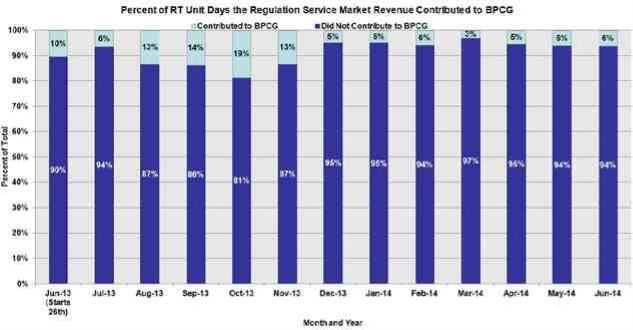
Honorable Kimberly D. Bose August 26, 2014
Page 6
FIGURE 2
The appearance of negative net revenue from Regulation Service may indicate the need
for a Bid Protection Cost Guarantee (“BPCG”) payment.16 Negative net revenue implies that a
unit’s costs for providing real-time Regulation Service on that day were not fully compensated
by payments for Regulation Service on that day. If net revenue from other market services on
that day was not enough to offset the losses in the Regulation Service market, such a unit would
be entitled to a BPCG payment. The relatively little negative net revenue from providing
Regulation Service in Real Time, revealed by Figure 2, indicates that on a significant majority of days, costs for providing real-time Regulation Service are compensated by payments for Regulation Service. Figure 2 also supports the conclusion that the use of a uniform RMM with the current Regulation Service market design is, with very few exceptions, compensating
Regulation Service providers for their costs.
A.3. Regulation Movement prices appropriately compensate for the
provision of that service.
The NYISO has similarly analyzed the negative net revenue from providing Regulation Movement to understand whether the market prices paid for Regulation Movement cover
suppliers’ bid-in Regulation Movement costs. As presented in Figure 3, on the majority of days in which units bid in real-time, resources were able to cover their bid-in cost for Regulation Movement with the market price for Regulation Movement.
16 A BPCG is paid only when the revenues from all market products sold over a day, including Energy,
Operating Reserves and Regulation Service do not cover all bids for those products for those days. As a result, the contribution of negative net revenue in providing Regulation Service as seen in Figure 3 does not necessarily
indicate a BPCG will be paid.
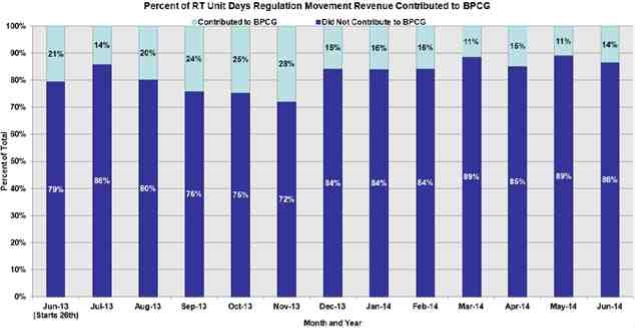
Honorable Kimberly D. Bose August 26, 2014
Page 7
FIGURE 3
From this data, the NYISO reasonably concludes that most units earn positive net
revenue each day for providing Regulation Movement under the NYISO’s market pricing
methodology. As mentioned, a BPCG will ensure that over the day, all resources are
compensated its bid-in costs for the Energy and Ancillary Service products provided for that day.
B. Data on the ratio between Regulation Movement and Regulation
Capacity shows that the set point of the uniform RMM may need to be adjusted to more accurately reflect the current dispatched
movement of Regulation Service providers.
As can be seen in Figure 4, the ratio of Regulation Movement to Regulation Capacity
increased after the implementation of market changes associated with Order 755 on June 26,
2013. In addition, the ratio of Regulation Movement to Regulation Capacity in real-time has
proven to be volatile. The data is not yet sufficient to reasonably establish whether the long term
trend in the ratio of Regulation Movement to Regulation Capacity is still rising, declining or has
stabilized.
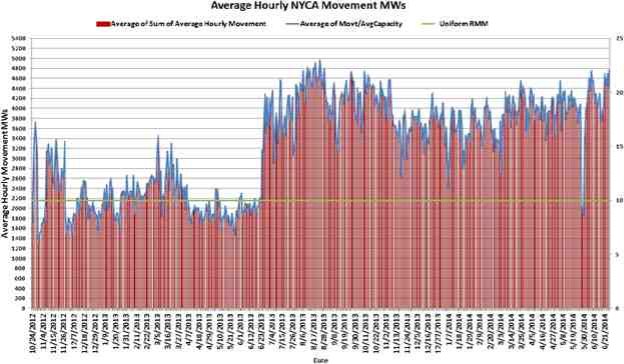
Honorable Kimberly D. Bose August 26, 2014
Page 8
FIGURE 4
Therefore, while the data indicates the current RMM may set too low, the NYISO does
not yet have sufficient data observations to be able to demonstrate the appropriate size of a
permanent adjustment. The NYISO does not want to initiate a change prematurely as a series of
changes may be detrimental to the market. The NYISO will continue to gather data in order to
establish a change to the uniform RMM that it is confident is both appropriate and will not
require a series of adjustments. It will pursue a change in the uniform RMM through the
stakeholder process. To the extent the data indicates a more appropriate RMM would include an
hourly or seasonal factor, it will suggest that as well in the stakeholder process.
The NYISO will begin its review with stakeholders of a revised RMM at the first MIWG in October, 2014. The NYISO’s goal is to present further data on the issue and, at a subsequent MIWG before the end of the year, either recommend an appropriate adjustment or explain why it does not have one.
C. Discrepancies, if any, between the established RMM and actual
movement scheduled on and provided by Regulation Service
providers does not impact the overall efficiency of the market prices paid for Regulation Movement.
The NYISO examined whether a discrepancy between the RMM and the actual
movement that Regulation Service resources provide impacts the efficiency of the market prices
paid for Regulation Movement under the existing implementation. On a theoretical level, setting
Regulation Movement and Regulation Capacity clearing prices through separate optimizations of
Honorable Kimberly D. Bose August 26, 2014
Page 9
each product, and separately selecting a marginal provider of each product could provide a more
efficient market price for Regulation Movement. However, the NYISO does not believe the
current market design negatively impacts the efficiency of these market prices and that a
redesign of the NYISO’s co-optimized selection of Energy, Operating Reserves and Regulation
Service providers is unnecessary. As mentioned in Section A.2 of this letter and as presented in
Figure 2, under the existing design, Regulation Service providers are covering the costs of
Regulation Movement with the market price received for Regulation Movement on the vast
majority of historic days evaluated. And the BPCG will ensure that over the day bid-in costs for
the energy products scheduled, including Regulation Service, will be recovered.
Nonetheless, the NYISO tested the potential efficiency of setting separate prices for
Regulation Capacity and Regulation Movement by creating a hypothetical model. In this model, the NYISO tested whether separately established Regulation Capacity and Regulation Movement prices would cover bid-in costs for the two products more completely and frequently than would market prices created using composite price bids. Establishing separate clearing prices for
Regulation Capacity and Regulation Movement would also eliminate the need to use an RMM, which is needed only if the market design uses composite bids.
Historical bids for Regulation Capacity and Regulation Movement were analyzed for
each hour between 8/1/2013 and 4/30/2014. Resource bids and ramp rates were used to create
supply curves for Regulation Movement which, in one of the two methods described below, were
also used to select units to satisfy the amount of Regulation Movement instructed in each hour of
the day.
Two conditions were considered. In one condition, the “Current Method,” a supply curve was created using each Regulation Service resource’s capacity MW and composite price bid.
This supply curve was used to select units to provide Regulation Capacity and determine the
marginal Regulation Service resource. The market price for Regulation Capacity and for
Regulation Movement was set at the Regulation Capacity bid and Regulation Movement bid,
respectively, of the marginal Regulation Service resource. Compensation for the Regulation
Movement of these units was calculated as a portion of the Regulation Movement historically procured for the hour, prorated across the resources selected for that hour based on their ramp rates and then multiplied by the Regulation Movement price.
In the other condition, the “Alternative Method,” each unit's Regulation Capacity bid and
the MW of Regulation Capacity available from the unit was used to create a supply curve to
select units to provide the Regulation Capacity requirement. The marginal Regulation Capacity
resource set the Regulation Capacity market price. Separately, each unit’s Regulation Movement
bid and ramp rate were used to create a supply curve and select units to provide the Regulation
Movement MW historically procured for the hour. Awards, to satisfy the Regulation Movement
historically procured within the hour, were based on the MW available from each resource over
the hour. The marginal Regulation Movement unit set the Regulation Movement price. As such,
the Regulation Movement price was set such that each scheduled unit’s Regulation Movement
offer would be economic.

Honorable Kimberly D. Bose August 26, 2014
Page 10
In both the Current Method and the Alternative Method resources were scheduled on an hourly basis, cross product opportunity costs were not included in prices, and resources were
assumed for the entire hour not to be ramp constrained. In both methods, hours were excluded from the analysis if the Regulation Demand curve applied to at least one interval. Total
settlements under both methods were calculated and settlement dollars were compared for each unit under both scenarios.
By measuring the difference in the two settlement dollar calculations for each resource,
the NYISO compared how well each method’s design compensated for the product provided. As
Figure 5 indicates, this analysis showed little difference in what each unit would be paid under
either scenario. The estimated average difference between the prices for Regulation Capacity
under the Alternative Method and Regulation Capacity under the Current Method is -$0.52. This
means that Regulation Capacity prices would be expected to decrease by 52 cents on average
under the Alternative Method relative to the Current Method. The estimated average difference
between prices for Regulation Movement under the Alternative Method and Current Method of
$.009 implies the Regulation Movement clearing price would be expected to increase by less
than one penny on average under the Alternative Method relative to the Current Method.
FIGURE 5
Thus, as figure 5 illustrates, whether scheduled using a composite bid created with an
RMM, or scheduled using separately calculated Regulation Capacity and Regulation Movement
supply curves and awarding Regulation Movement to the most economic supplier of Regulation
Movement,17 Regulation Service suppliers were paid nearly identical amounts. The NYISO
presented the aforementioned analysis as part of its stakeholder process on July 7, 2014. 18
17 The Alternative Method used two supply curves to choose the marginal providers of Regulation
Capacity and Regulation Movement but did not attempt to fully co-optimize the trade-offs between Energy,
Operating Reserves and Regulation Service that the NYISO provides in its market software. Neither did the NYISO adjust for behavior changes that may occur with such a change in market design. Nonetheless, the NYISO believes the overall findings of its analysis are appropriate to this exercise. The NYISO believes the results shown here
would have been comparable even had the Alternative Method incorporated a co-optimized scheduling of
Regulation Capacity and Regulation Movement or had the NYISO taken into account behavior changes that may
accompany a co-optimized market design.
18 This analysis was presented to Market Participants at a 7/7/2014 MIWG using a presentation found at -
http://www.nyiso.com/public/webdocs/markets_operations/committees/bic_miwg/meeting_materials/2014-07-
07/Frequency%20Regulation%20Compensation%20July%20MIWG%20FINAL.pdf
Honorable Kimberly D. Bose August 26, 2014
Page 11
The NYISO determined that, given the technical hurdles, and the time and cost of
redesigning the NYISO’s co-optimized selection of Energy, Operating Reserves and Regulation
Service providers - a dramatic scheduling and pricing revision in the NYISO’s Day-Ahead and
real-time market software - the relatively modest gains in market efficiency are far outweighed
by the cost of pursuing them. To date, the NYISO’s stakeholders have provided no feedback
opposing this conclusion. In addition, the results of this exercise demonstrate that the use of a
uniform RMM is not a major contributor to inefficiencies in market prices for Regulation
Movement. This conclusion is also discussed below.
D. The data analyzed do not indicate it would be more appropriate to use
resource specific RMMs. A resource-specific RMM that recognizes faster-ramping resources scheduled to provide Regulation Capacity are likely to provide more Regulation Movement than slower-ramping resources is unnecessary to provide appropriate compensation for
Regulation Movement provided.
A uniform RMM remains the appropriate approach to provide comparability between Regulation Capacity and Regulation Movement price offers given the manner in which the NYISO schedules Regulation Service providers. If utilized with the current market design, resource-specific RMMs would cause faster units to appear more expensive to the optimization and thus less likely to be scheduled than slow resources.19
As established in the NYISO’s January 22, 2013 filing, the use of a uniform RMM does
not result in under-compensating a unit that provides more Regulation Movement than assumed
by the uniform RMM.20 The NYISO’s current implementation recognizes that faster-ramping
resources scheduled to provide Regulation Capacity likely will provide more Regulation
Movement than slow-ramping resources by prorating the need for Regulation Movement in AGC
based on resource ramping ability. In this way, faster moving resources will be scheduled to
provide more MW, and be compensated for more MWs at the market price for Regulation
Movement. By prorating the dispatch, and paying resources for the amount of Regulation
Movement they provide, the NYISO appropriately recognizes a faster resource’s ability to
provide more Regulation Service.21
19 The Commission was correct when it pointed out in its November Order at ft.nt 66 that “Resource
specific RMMs would increase the likelihood that a resource with a high cost of movement may not be considered economic during the Regulation Market clearing process under the NYISO’s current Regulation Service market methodology implemented in compliance with Order 755.”
20 New York Independent System Operator, Inc. Docket No. ER12-1653-000, Compliance Filing, January 22, 2013, (“January Filing”) p.4
21 See P 31 of the May Order wherein the Commission accepted that the use of a uniform RMM in the
clearing process, combined with the use of the resource-specific Regulation Movement Response Rate in dispatch, will result in reasonable commitment of and compensation to frequency regulation resources and that the use of the Regulation Movement Response Rate in the dispatch algorithm will dispatch available resources to meet system needs. “This will ensure that faster responding resources, which will be requested to provide more frequency
regulation service, will have their greater Regulation Movement reflected in their compensation.”
Honorable Kimberly D. Bose August 26, 2014
Page 12
E. The market power mitigation proposal that the NYISO offered in its
January 22, 2013 compliance filing meets the requirements of Order No. 755 and the November 6, 2012 Order as a permanent market power mitigation method.
The NYISO monitors for and mitigates uncompetitive conduct in the Regulation Service market through a conduct and impact assessment that depends upon appropriately set reference prices.22 Currently, the tariff provides that reference levels for Regulation Movement are to be determined through estimation by the NYISO and/or consultation with the resource, but not
through historical bids.23 As explained in the Affidavit of Pallas LeeVanSchaick in the NYISO’s January Filing, using historical bids to establish Regulaion Movement reference levels is
inappropriate, since resources are not incented to bid their Regulation Movement costs under the current Regulation Service market methodology:
[Because] regulation suppliers do not generally have an incentive to submit Regulation
Movement Bids at marginal cost, . . . the bid-based reference level calculation method [is] unsuitable for the Regulation Movement Bid parameter.24
Resources are not incented to bid least cost because they are scheduled based on the
composite bid offers and settled base on the Regulation Movement bid of the marginal
Regulation Capacity supplier. The NYISO’s analysis reveals, however, that any potential market power issues that may present themselves because the NYISO’s market does not provide a
market-based incentive to bid Regulation Movement at least cost have been successfully
alleviated with the Market Mitigation measures accepted as interim measures in the
Commission’s May Order.25
As Figure 6 illustrates, the total cost of the Regulation Service market has remained
roughly the same with the implementation of Order 755. Even though the absence of an
incentive to bid at least cost has the potential to increase the total cost of Regulation Service
considerably, the absence of increased costs to consumers implies that any incentive to bid more
than least cost is not being observed.26 Moreover, the NYISO has seen few instances of
mitigation since the movement component of the Regulation Service market was introduced.
22 See, generally, Attachment F, Section 21 of the Services Tariff.
23 Regulation Capacity reference levels may be set by reviewing the historical bids that have been
scheduled. As documented in Services Tariff Section 23.3.1.4, a reference level based on a Generator’s accepted Bids during competitive periods is the preferred calculation method, provided the NYISO has adequate
data.
24 January Filing Attachment I, P 13
25 May Order P 35
26 See: Jie Chen, Pallas LeeVanSchaick, and David Patton, 2013 State of the Market Report for the New York ISO Markets, Potomac Economics, May 2014 at Appendix J for a review of the operation of the Regulation Service Market for 2013, including the first six months of the new design.
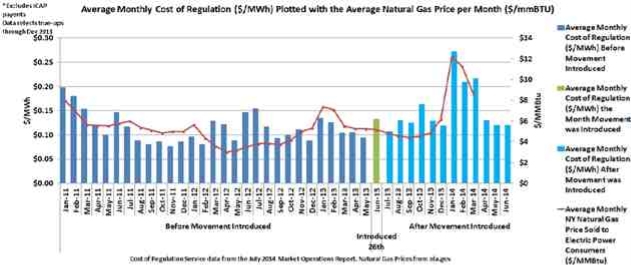
Honorable Kimberly D. Bose August 26, 2014
Page 13
FIGURE 6
Resources may review their reference levels with the NYISO and, if they can justify a
higher reference level through the NYISO’s consultation process, the NYISO will establish a
higher reference level, allowing the resource to offer Regulation Movement and/or Regulation
Capacity at a higher price. Nonetheless, reference levels are unlikely to be higher than would be
appropriate given the reference level development discussed above as the NYISO uses an
estimation process to measure the appropriateness of existing reference levels and, when
appropriate, has revised unit references downward. Of course, Market Participants may consult
on these changes and when presented with a justification for not lowering them, the NYISO will
reset them.
The NYISO’s independent Market Monitoring Unit has authorized the NYISO to indicate that it supports the current mitigation protocols for Regulation Service providers and agrees they should be considered permanent measures. The MMU will be supplying a letter in support of that conclusion concurrently with this filing. Therefore, the NYISO believes the current
Regulation Service market mitigation measures are supportable and sufficiently robust to be
considered permanent mitigation measures in this market.
Honorable Kimberly D. Bose August 26, 2014
Page 14
IV.Communications
Communications and correspondence regarding this filing should be directed to:
Robert E. Fernandez, General Counsel
Ray Stalter, Director of Regulatory Affairs
*Mollie Lampi, Assistant General Counsel
New York Independent System Operator, Inc.
10 Krey Boulevard
Rensselaer, N.Y. 12144
Tel: (518) 356-6000
Fax: (518) 356-4702
rfernandez@nyiso.com
rstalter@nyiso.com
mlampi@nyiso.com
*Persons designated to receive service
V.Conclusion
The NYISO respectfully requests that the Commission accept this informational filing in compliance with its directives as stated herein.
Respectfully submitted,
/s/ Mollie Lampi
Mollie Lampi
Assistant General Counsel
New York Independent System Operator, Inc.
10 Krey Blvd.
Rensselaer, New York 12144 (518) 356-7530
mlampi@nyiso.com
cc:Michael Bardee
Gregory Berson
Anna Cochrane
Jignasa Gadani
Morris Margolis
Michael McLaughlin
David Morenoff
Daniel Nowak
CERTIFICATE OF SERVICE
I hereby certify that I have this day served the foregoing document upon each person
designated on the official service list compiled by the Secretary in this proceeding in accordance with the requirements of Rule 2010 of the Rules of Practice and Procedure, 18 C.F.R. §385.2010.
Dated at Rensselaer, NY this 26th day of August, 2014.
/s/ Joy A. Zimberlin
Joy A. Zimberlin
New York Independent System Operator, Inc.
10 Krey Blvd.

Rensselaer, NY 12144 (518) 356-6207






